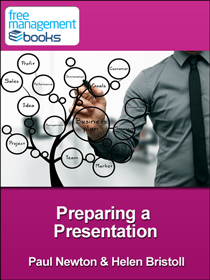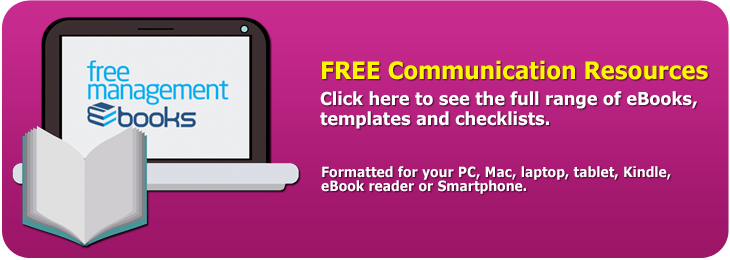Preparing a Presentation - Free eBook in PDF Format
 |
 |
|
Book Description - ISBN 978-1-62620-965-7 (47 Pages)
This free eBook follows on from 'Planning a Presentation' and explains how to create a complete presentation based on your aim, audience, key message statement, and the key points you have identified.
Chapter 1 - Preparing a Management Presentation
The competencies you display during presentations can help your career prospects, particularly if you can show that you are a persuasive speaker.
Chapter 2 - Repetition and Timing
An effective presentation requires a certain amount of repetition in order to get the message across to the audience. This repetition needs to be allowed for in the timings that you allocate for each part of the presentation.
Chapter 3 - Your Presentation Aim
The aim statement serves to keep you focused on what it is you are trying to achieve. It also makes it easy to come up with a key message statement, which is what you want your audience to remember at the end of the presentation.
Chapter 4 - The Five-Stage Format
The five-stage format of a pre-introduction, introduction, main body, summary, and conclusion is suitable for most workplace presentations.
Chapter 5 - Preparing the Main Body
The first stage is to prepare the main body of the presentation because all of the other stages are dependent on it. The most common problem that people have when developing a presentation is to underestimate how long it is going to take to deliver.
Chapter 6 - Key Point Guidelines
There are a series of guidelines that you can use to make sure that your key points are clear, logical and easy to understand.
Chapter 7 - Finalizing the Main Body
If the presentation is an important one, then work through this draft with a trusted colleague as this can help to get the structure and emphasis right and leave you with more time to fine-tune it.
Chapter 8 - Preparing Your Pre-Introduction
A pre-introduction serves to get people's attention and to ensure that they are listening to you so that they can hear your full introduction.
Chapter 9 - Preparing the Introduction
The introduction should tell the audience your key message and your credentials and should also tell them how your presentation is structured and how long it is going to take. It is your first opportunity to make it clear to the audience that following your presentation is not going to be hard work.
Chapter 10 - Preparing the Summary and Conclusion
The function of the summary is to make it clear that you are moving towards the conclusion of the presentation. You can summarize by restating the key message statement and how the key points support it. Your conclusion should be one single sentence that refers back to the key message statement.
| You will learn: |
|
![]()
![]()
Offers some great advice
The 'Preparing a Presentation' eBook offers some great advice to anyone in a position that requires giving presentations on a regular basis. For me personally, presentations are always a challenge, and not one that I necessarily look forward to. Instead of staying afraid of my upcoming presentations, I decided to seek out information that could help me be better prepared and able to do a quality job. This book doesn't contain all of the answers needed for a good presentation, but it is an excellent start. There are several points within this book that any presenter would benefit from considering.
Right off the bat this book hits on a point which I found to be interesting and very valuable. The idea that repetition in a presentation is not necessarily a bad thing, when done the right way. As long as you make your point in a different manner each time, being repetitive can actually be an effective way to make your point clear. I will remember this and not back down from hammering home the same point throughout my presentations to make sure it is not missed. In the past I have avoided doing this for fear that I would bore the audience. I now understand, however, that by varying the way I say the same thing, I can make the point stronger while still keeping the audience engaged.
Another strong point made in this book is the idea of remaining focused on the aim of your presentation. It is easy, for me at least, to drift off topic and start discussing items that don't really further the point of the presentation itself. Thanks to the advice of this book, I am going to make sure that I keep my aim and goal at the top of my mind throughout the planning and preparing phase of the presentation.
Breaking the presentation into stages is an idea that I agree with, but wasn't necessarily new to me. I found that section to be a little bit basic in terms of concept, but important nonetheless. If anything, it can serve as a reminder that it is important to have specific sections of your presentation all serve a purpose toward your end goal. One item within this section that I did find useful was the idea of a pre-introduction. All presenters are familiar with the problem of having an 'unsettled' audience at the start of a presentation, so using a pre-introduction to get attention without saying anything too important is a smart idea in my opinion. I definitely plan on using this technique in my next presentation to make sure that the audience is engaged before I get into the meat of my content.
One subtle point that I drew from this book which I think is important is to never assume that your audience knows what you are going to say or what you want them to get out of the presentation. You need to be overt and obvious with your points. My tendency is to take some things for granted and gloss over details that perhaps not everyone in the room understands. If I can just be more detailed and more careful to be thorough during my future presentations, this eBook will have been of benefit to me.
Don't hesitate to spend some time reading this short eBook. I anticipate that you will find at least a few points that can help your presentation preparation. Whether you give presentations on a regular basis or only once in a while, improving your process is worth the effort.
Ollie Lorrimer
A solid refresher or a complete learning guide
Preparing a presentation can be a bit of a stressful occasion and as I was preparing one for a recent board meeting, I was certainly not impervious to the pressure. In my role with the company I do not regularly have to present to the board so I needed a little refresher course to say the least. While browsing the internet I stumbled across www.free-management-eBook s.com and found that they offered quite a few useful books on presentations as well as other management books. That being said I found this guide on preparing a presentation to be a much needed refresher. Even better, I have found the author of this book to use a straightforward and easily understood writing style that spares us all on $10 words.
If you guys are as pressed for time as I usually am, you will find this book to be a breath of fresh air, and to save you some time finding the perfect book, I would like to highlight just a few of the key points of this book for you below. Preparing a presentation systematically is the first topic tackled and if you are anything like me, the tips couldn't have come any sooner. Using a very simple four step approach you will learn to identify your aim, know you audience, define your key message, and outline the scope of your presentation.
Once you know the who and what of your presentation, you can then set forth to write the content for your presentation. As you begin create the content you will also want to consider a few key points. Is your argument well-structured? Did you clearly define your key message in such a way to gain support? Is your message audience appropriate? Among other things, those are a few key considerations outlined and explained in the book. One point of the book I really enjoyed was the section covering how to make your point which includes a quote from Winston Churchill. "If you have an important point to make, don't try to be subtle or clever. Use a pile driver." Essentially they are conveying the message that you should clearly make your point and do not be afraid to revisit it regularly. As a matter fact they suggest you hit your point, hit it again, and then come back for a third time, driving it home.
Diving deeper into what makes a good presentation, you will also learn what differentiates a good presenter from someone simply reading. Leaning back towards structure you will also learn about a five stage format for preparing which includes the pre-introduction, introduction, main body, summary, and conclusion. In my opinion segmenting a larger task will often make it more manageable and this book does a great job of explaining how to do it. If you have a presentation coming up, scanning over this book can provide a solid refresher or a complete learning guide. I also recommend checking out some of the other books if you like this one as they are share the same user friendly layout and straightforward approach.
Sarah Brewer


